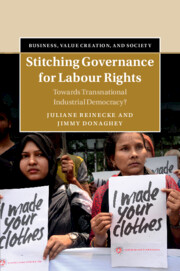Book contents
- Stitching Governance for Labour Rights
- Business, Value Creation, and Society
- Stitching Governance for Labour Rights
- Copyright page
- Contents
- Figures and Tables
- Foreword
- Foreword
- Acknowledgements
- Abbreviations
- 1 Introduction
- 2 The Democratic Deficit of Global Supply Chains
- 3 Democratic Representation
- 4 After Rana Plaza
- 5 Representative Alliances in the Creation of the Bangladesh Accord
- 6 Creating Representation through Industrial Democracy versus CSR
- 7 When Transnational Governance Meets National Actors
- 8 Building Representative Structures at the Workplace Level
- 9 Conclusion
- Book part
- References
- Index
3 - Democratic Representation
Structures and Claims
Published online by Cambridge University Press: 09 March 2023
- Stitching Governance for Labour Rights
- Business, Value Creation, and Society
- Stitching Governance for Labour Rights
- Copyright page
- Contents
- Figures and Tables
- Foreword
- Foreword
- Acknowledgements
- Abbreviations
- 1 Introduction
- 2 The Democratic Deficit of Global Supply Chains
- 3 Democratic Representation
- 4 After Rana Plaza
- 5 Representative Alliances in the Creation of the Bangladesh Accord
- 6 Creating Representation through Industrial Democracy versus CSR
- 7 When Transnational Governance Meets National Actors
- 8 Building Representative Structures at the Workplace Level
- 9 Conclusion
- Book part
- References
- Index
Summary
Chapter 3 focuses on the challenges and opportunities of transnational worker representation and their consequences for the development of more democratic governance institutions. We examine these from two key theoretical perspectives. Starting from the notion of associational democracy, we differentiate between two logics of democratic representation: representation as claim versus representation as structure. The first approach is associated with a discursive or communicative model of transnational democracy as put forward by political theorists. Rather than thinking of representation in terms of representative structures, representation becomes the dynamic and ongoing process of making “representative claims” that reflect certain discourses, categories, concepts, judgments, dispositions, and capabilities. In contrast, structural ideas of representation are grounded in industrial democracy. Here, constituents of an organic political unit defined by voluntary membership, such as a trade union, authorise their representatives to deliberate, negotiate or bargain on behalf of members. We develop their theoretical grounding in structuralist and post-structuralist thinking, and question to what extend these approaches may be reconciled with each other to advance prospects for transnational worker representation.
Keywords
- Type
- Chapter
- Information
- Stitching Governance for Labour RightsTowards Transnational Industrial Democracy?, pp. 46 - 69Publisher: Cambridge University PressPrint publication year: 2023

